A radar level transmitter measures the distance between the transmitter installation point and the surface of a process material located at a distance. It measures the distance by measuring the time of flight of a traveling wave.
Radar level transmitters are the most widely used level transmitters in many critical applications. Radar level transmitters accurately measure the levels in the tank. Basically, the radar level transmitter works on a very basic principle of time of flight.
Time of flight Principle
Time of flight is the time taken by any wave or particle to travel through a given medium, after being reflected from the object. The total time taken by these waves or particles is termed as the time of flight.
Let, t1 = Time taken by wave from transmitter to target
t2 = Time taken by wave to reflect back to receiver
Time of flight( TOF) = t1 + t2
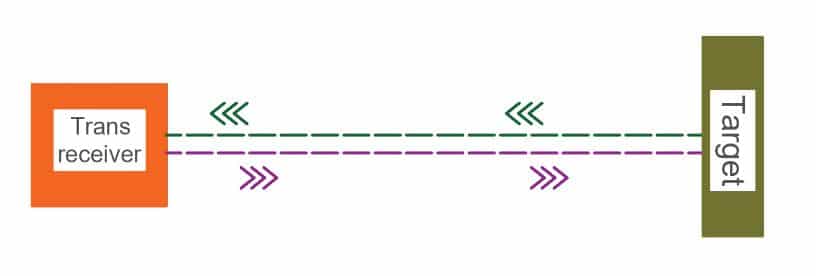
Working of Radar Level Transmitter
As shown in the above image, a trans receiver sends and receives waves. It calculates the time taken by the waves to go towards the target, reflect from it and come back.

The speed of the waves is equal to the speed of light( 3 X 108 m/s). The transmitter algorithm calculates the time. Thus, by using the above-mentioned formula, the radar level transmitter calculates the distance between the trans receiver and target.
The radar type level transmitter has a trans receiver that sends the electromagnetic wave signal and receives the signal after reflecting from the object. Thus, the transmitter measures the time of flight.
The basic working of the radar transmitter is sending the microwaves (which can be of different frequencies for different applications) to the vessel or the tank and knowing the time it takes to travel to and fro from the level filled in the vessel or the tank. Using the formula, distance= speed X time, the radar transmitter calculates the distance from the transmitter to the top of the material filled in the tank.
The important factor in selecting the frequency of the microwave is dependent on the dielectric constant of the filled material and vapors and also the medium present above the fill level.
The measuring accuracy of the radar level transmitter depends on the dielectric of the object. The object that has high dielectric absorbs the microwave more, and the measurement accuracy is less because of the less received signal at the transmitter. In this case, the microwave frequency must be higher.
Types of Radar Level Transmitters
There are 2 types of radar type level transmitters. 1 is a non-contact type radar level transmitter and the other is a contact type radar level transmitter.
- Contact type Radar Level Transmitter
- Non Contact type Radar Level Transmitter
Contact type Radar Level Transmitter
Contact type radar transmitters have an antenna or trans receiver connected with a probe going to the end of the vessel or the tank. The antenna or trans receiver sends microwave signals through the probe.
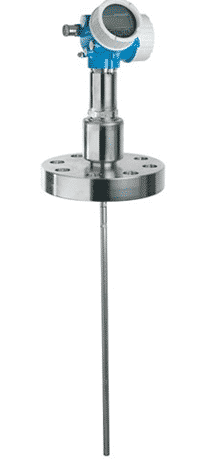
When these microwave signals hit the surface, they reflect and move back towards the antenna or trans receiver. Here a part of microwaves further travel to the bottom of the tank and reflects from there. Figure 1 shows how microwave forms echo when no material is there in the vessel or the tank. Figure 2 shows how microwave forms echo when material there is material in the vessel. The transmitter understands the echo only and translates it into equivalent levels. More echoes forms in the case of interference.

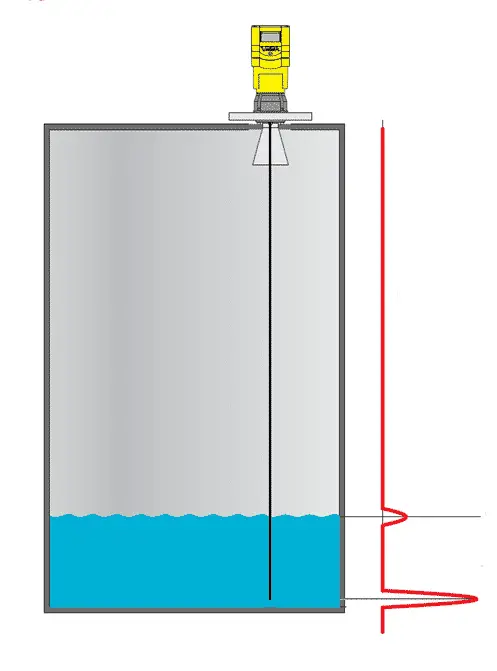
Non-Contact type Radar Level Transmitter
Non-contact type radar level transmitters have an antenna or say trans receiver and a processing circuit. The antenna or trans receiver is protected inside a cone shape for sensing microwaves in a straight path in order to get better measurement accuracy.
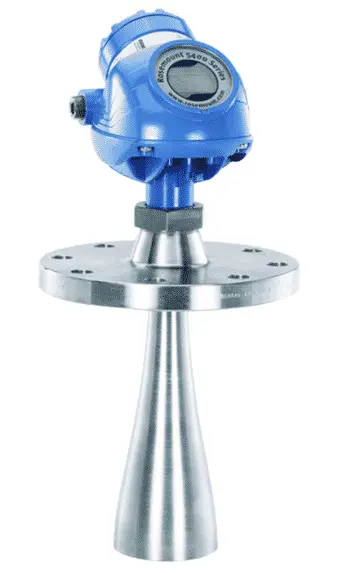
The antenna/trans receiver sends high-frequency microwave signals inside the tank or vessel. These microwave signals reflect from the top of the material which they hit. Then, the receiver of the transmitter receives the reflected waves. The transmitter calculates the time between sending of waves and receiving of waves. The transmitter calculates the distance using the formula, distance = Speed x Time
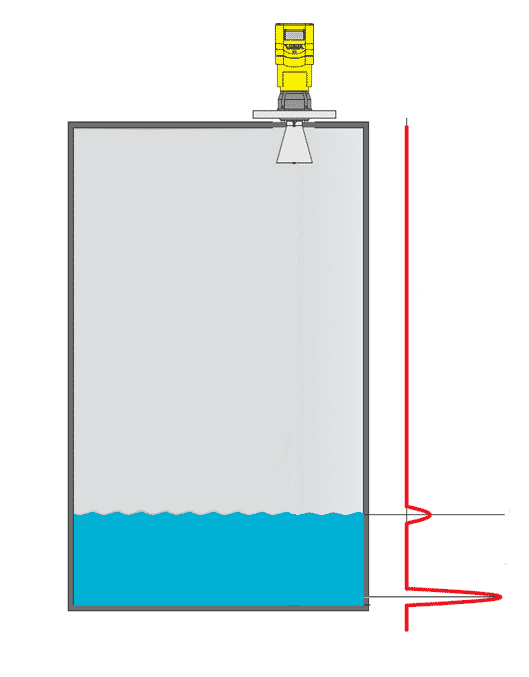
The measuring accuracy affects if the antenna of the transmitter gets dirty. The periodic cleaning is a must for accurate level measurement. In modern transmitters, the automatic antenna cleaning system is available.
How do the dielectric constant effects the measurement?
The dielectric constant of the filled material and vapors present in the empty space above the filled level affects the measuring accuracy. The vapor cause interference in the path of microwaves. Therefore, it is important to consider these factors while measuring. This plays a very important role in measuring the actual level.
The dielectric constants of the mediums or fluids present should be having a significant difference. Because if dielectric constants are near about the same, then no significant difference in reflected echoes. This highly depends on the frequency of the microwave used also. The selection of a particular frequency for given dielectrics is very typical. Always consult the vendor before implementing changes or ordering a new transmitter.
Different radar level transmitters are available for interface measurement. The minimum difference in dielectric constant for accurate level measurement is 5.
Advantages of Radar type level transmitter
- Radar type level transmitters are suitable for measuring levels of liquids, solids, slurries, or interfaces.
- Since there is no moving part, maintenance is very less.
- No effects on measurement by liquid turbulence, change in density, temperature change, and pressure change.
- Non-contact type radar level transmitters are most suitable for highly corrosive fluids as well.
Limitations of Radar type level transmitter
- If there is a change in the material’s dielectric constant, then readings will vary.
- In using contact type radar, if any material sticks on the probe, then it will form echoes and we will get the wrong reading. We need to pull the probe out and clean and again reinstall.
- In non-contact type radar also, if any material sticks on the antenna, then we need to clean it.
- For interference measurement, the minimum difference in dielectric constant should be 5. Else we won’t be able to measure interface echo properly.
Applications of Radar Level Transmitters
- Mining Industry
- Captive Power Plant
- Paper and pulp industry
- Aeronautics industry
- Cement Plants
- Steel Plants
Read Next: